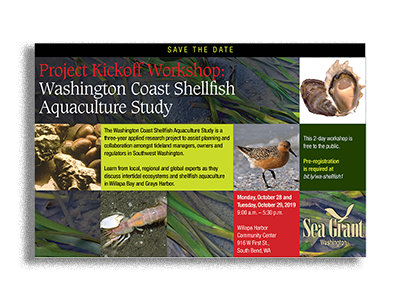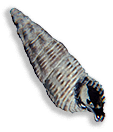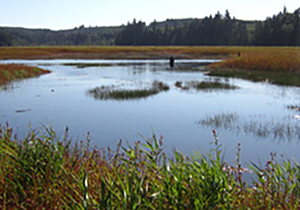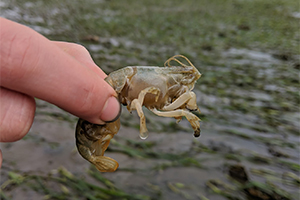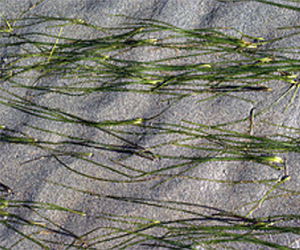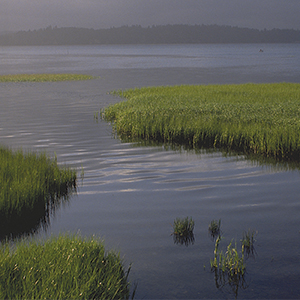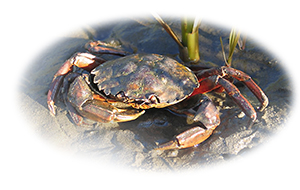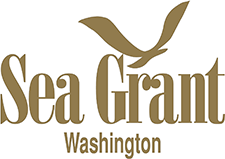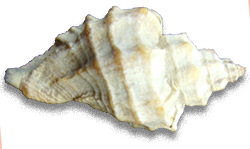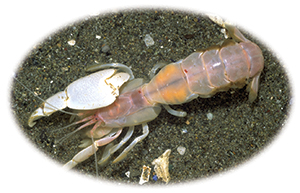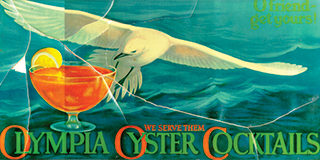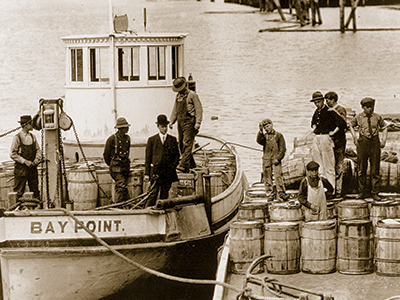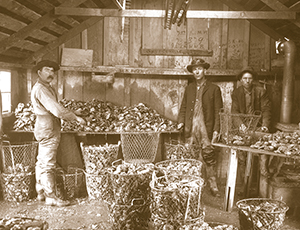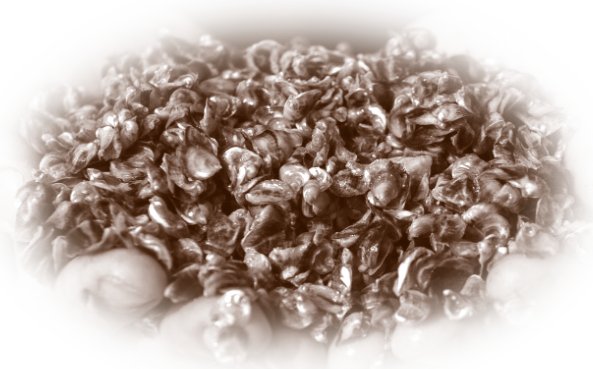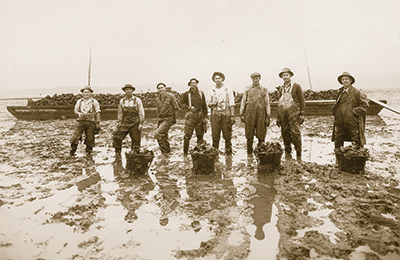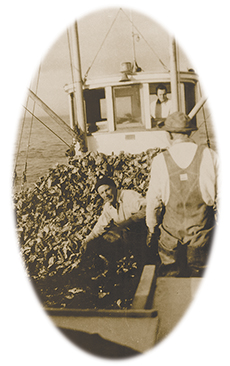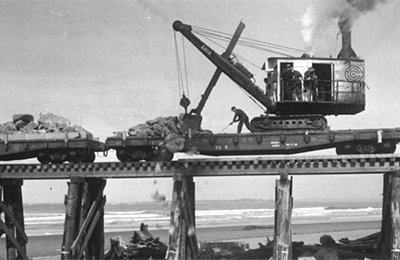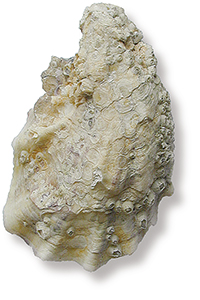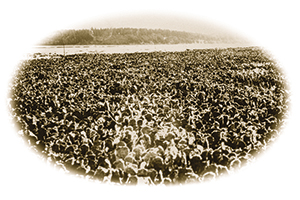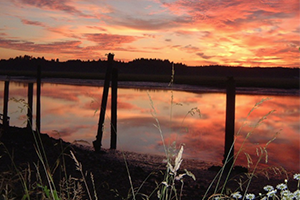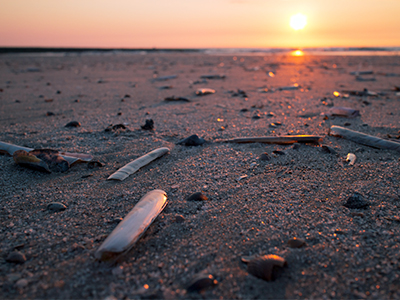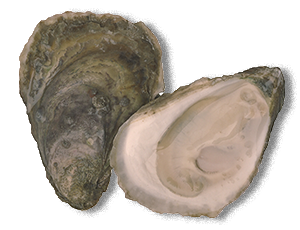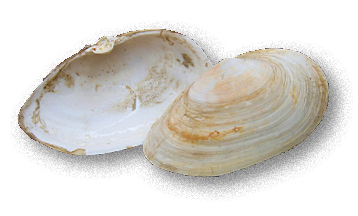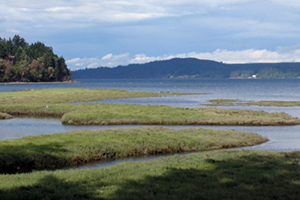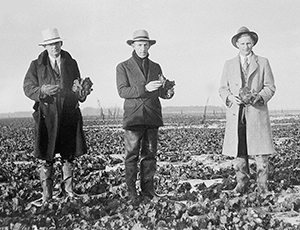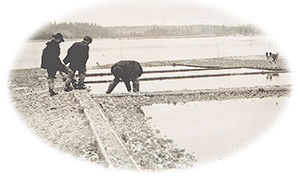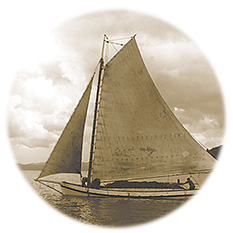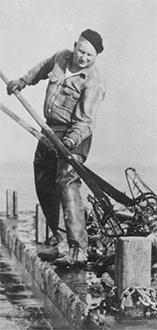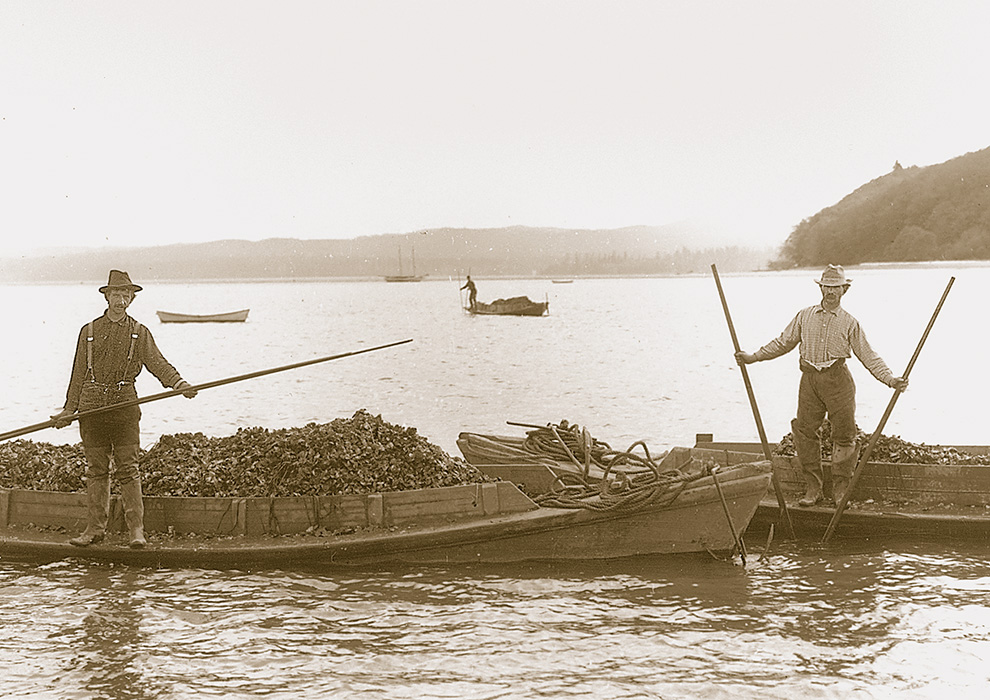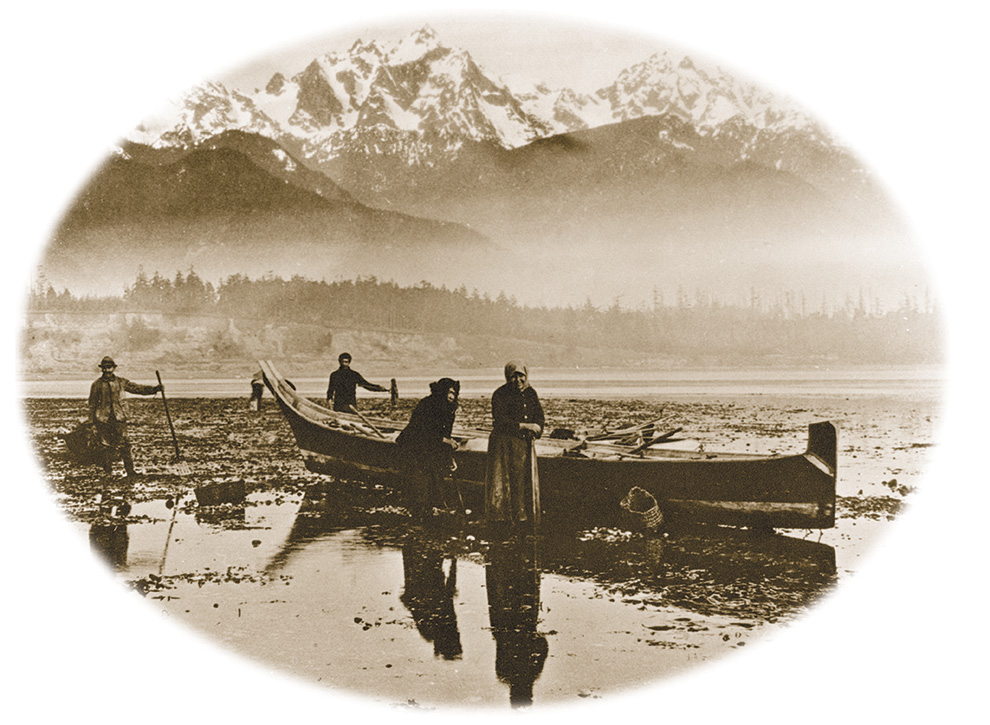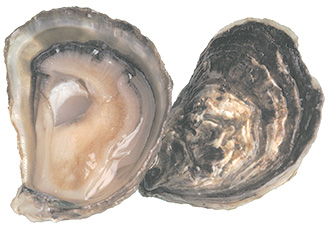Washington Coast Shellfish Aquaculture Timeline
Welcome to the Washington Coast Shellfish Aquaculture Timeline. This project is part of the Washington Coast Shellfish Aquaculture Study project, which is an effort to improve the long-term sustainability of shellfish aquaculture in Willapa Bay and Grays Harbor under changing environmental conditions.
The study is coordinated by Washington Sea Grant and advised by a team of independent scientists and a diverse working group representing owners, managers, and regulators of tideland resources in the two estuaries. This study is intended to provide solutions to current challenges and support the creation of an ongoing structure to facilitate problem-solving as challenges continue to arise in our region for shellfish growers.
The timeline is a working document intended to provide an overview of the history of shellfish aquaculture and its challenges, and give a sense of the major events related to shellfish aquaculture, specifically in the Willapa Bay and Grays Harbor estuaries of Washington State from 1850 to the present.
As a working document, we are continually adding content and updating information to the timeline. If you have content to contribute, please contact Brent Vadopalas, Washington Sea Grant aquaculture specialist, at brentv@uw.edu. This project was funded in part by the Governor’s Office, the Washington State Legislature, and Washington Sea Grant.
Washington Sea Grant created this timeline using the best available records, including Washington State Session Laws, peer-reviewed scientific literature, historical accounts, federal and state agency reports, and historical newspapers. Additionally, we added verified information from personal communications that were made available. In particular, we relied on information provided by Brady Blake, a shellfish biologist with the Washington Department of Fish and Wildlife, whose in-depth knowledge of shellfish harvest and culture history was critical to the project.
June 23, 2022
Around this time last year, the Pacific Northwest experienced excruciating, record-breaking heat. With funding from Washington Sea Grant, a team led by the University of Washington has compiled and analyzed hundreds of field observations to produce the first comprehensive report of the impacts of the 2021 heat wave on shellfish. The researchers found that many shellfish were victims of a “perfect storm” of factors that contributed to widespread death: The lowest low tides of the year occurred during the year’s hottest days — and at the warmest times of day. The results were published online June 20 in the journal Ecology. Read more on UW News here.
Coast Shellfish
Ecosystem-based Management Project
April
Working group webinar 3: Synthesis report and historical shellfish aquaculture timeline (workshop 2 postponed due to COVID-19)
Coast Shellfish
Ecosystem-based Management Project
February
Working group webinar 2: Updates from science partners
Coast Shellfish
Ecosystem-based Management Project
September
Working group formed
burrowing shrimp
Settlement agreement between Willapa Grays Harbor Oyster Growers Association and Washington Department of Ecology to drop the imidicloprid permit appeal given the support of research projects to develop the Integrated Pest Management plan.
major anthropogenic physical disturbance
Columbia River: rehabilitation of South Jetty commenced
Coast Shellfish
Ecosystem-based Management Project
Fall
Washington Coast Shellfish Aquaculture Study initiated
burrowing shrimp
Supplemental Final Impact Statement (SFEIS) for the use of imidacloprid to manage burrowing shrimp was released. Revised imidicloprid permit application denied by Washington Department of Ecology. Willapa Grays Harbor Oyster Growers Association appeals the permit denial decision to the Water Pollution Control Hearings Board.
major anthropogenic physical disturbance
Columbia River: rehabilitation of North Jetty commenced
BURROWING SHRIMP
Revised imidicloprid permit application denied.
major anthropogenic physical disturbance
Columbia River: rehabilitation of Jetty A completed
burrowing shrimp
Revised imidicloprid permit application submitted.
U.S. Environmental Protection Agency releases a Preliminary Aquatic Risk Assessment (RA) to Support the Registration Review of Imidacloprid.
burrowing shrimp
Final Environmental Impact Statement (FEIS) for the use of imidacloprid to manage burrowing shrimp was issued, followed by a National Pollutant Discharge Elimination System (NPDES) Waste Discharge Permit (WDOE). Permit for imidacloprid application requested, denied (Doenges et al 2018). Willapa Bay Grays Harbor Oyster Growers Association withdrew NPDES permit after intense media coverage.
BURROWING SHRIMP
Burrowing shrimp control with carbaryl discontinued
burrowing shrimp
Field trials of imidacloprid were detailed in a Sampling and Action Plan (SAP) by Washington State University, University of Washington, Pacific Shellfish Institute, Willapa Grays Harbor Oyster Growers Association, and Washington Department of Ecology.
burrowing shrimp
National Pollutant Discharge Elimination System permit work on imidacloprid for burrowing shrimp initiated (Patten, pers. Comm.). Burrowing Shrimp Integrated Pest Management Plan updated by the Willapa Grays Harbor Oyster Growers Association (WGHOGA). Crop Profile for Bivalve (Oysters, Manila Clams, Geoduck Clams and Mussels) Aquaculture in Washington was developed by Washington State University and WGHOGA. The Pest Management Strategic Plan (PMSP) for Bivalves in Washington and Oregon was the primary outcome from a planning workshop that was attended by primary stakeholders from all growing regions in Washington and Oregon, held by the Western Integrated Pest Management Center at Oregon State University.
burrowing shrimp
Federal and State Experimental Use Permits were issued from U.S. Environmental Protection Agency and Washington State Department of Agriculture for large scale (50+ acre) field trials of granular and liquid formulations of imidacloprid to assess efficacy, fate and transport, and impacts on sturgeon, crab, and benthic invertebrates.
burrowing shrimp
Burrowing Shrimp Integrated Pest Management Plan updated by the Willapa Grays Harbor Oyster Growers Association. Washington State University conducts studies to measure residues of the insecticide imidacloprid (Nuprid 2F) in oyster meat following field applications were begun under the Inter-regional Research Project #4 (IR-4) program for registration of pesticides in minor crops; and using certified Good Laboratory Practices (GLP) personnel and protocols.
BURROWING SHRIMP
Imidacloprid studies conducted for control of burrowing shrimp (Patten, pers. comm.)
shellfish and cultivation
43 non-native species reported from Willapa Bay (Wonham and Carlton 2005)
burrowing shrimp
The Willapa Bay Grays Harbor Oyster Growers Association (WGHOGA) agreed to settle a legal challenge of the use of carbaryl by successively reducing on the amount of carbaryl applied per year with full termination by 2012. Signatories were the Toxics Coalition, the Ad-hoc Coalition for Willapa Bay, several state agencies, and the WGHOGA. Burrowing Shrimp Integrated Pest Management (IPM) plan released by WGHOGA.
burrowing shrimp
The Willapa Bay Grays Harbor Oyster Growers Association was required by Washington Department of Ecology to apply for a National Pollutant Discharge Elimination System permit for applications of carbaryl to Willapa Bay and Grays Harbor.
burrowing shrimp
The Willapa-Grays Harbor Oyster Growers Association (WGHOGA) voluntarily entered into Memorandum of Agreement (MOA) with several groups to develop an Integrated Pest Management (IPM) program for burrowing shrimp. An IPM Coordinator was hired and an IPM Committee was formed, including WGHOGA, Washington State Department of Agriculture, Washington Department of Fish and Wildlife, Washington Department of Ecology, Washington State University, Washington State Commission on Pesticide Registration, Pacific Coast Shellfish Growers Association, Pacific Shellfish Institute, the Toxics Coalition and the Ad-hoc Coalition for Willapa Bay.
major anthropogenic physical disturbance
Columbia River: 2000s–main channel deepened to 13 meters
shellfish and cultivation
Eastern softshell clam deposits/death assemblages remain in Grays Harbor south channel, prominent feature alongside oysters and eelgrass (Palacios et al. 2000)
shellfish and cultivation
Non-native green crab Carcinus maenas reported in Willapa Bay and Grays Harbor.
burrowing shrimp
A study commissioned by Battelle Pacific Northwest National Laboratory recommended that an Integrated Pest Management Plan for burrowing shrimp be developed.
burrowing shrimp
Studies with imidacloprid initiated to control burrowing shrimp (Doenges et al. 2018)
spartina
Application of Integrated Pest Management Plan strategies to Spartina control.
spartina
Washington Department of Agriculture appointed to manage Spartina
legislative action
The Rafeedie Decision affirmed tribal shellfishing rights and co-management responsibility to signatory tribes in Washington.
spartina
Publication of the Noxious Emergent Plant Management Environmental Impact Statement for Spartina.
burrowing shrimp
Final Supplemental Environmental Impact Statement issued for the use of carbaryl by Washington Department of Fish and Wildlife and Washington Department of Ecology. The Burrowing Shrimp Control Committee was formed through the Washington State Legislature to develop a plan for continued control and Integrated Pest Management development. The membership consisted of agencies, legislators, tribes, and shellfish farmers.
spartina
Spartina control was attempted via mowing, covering, digging, crushing, disking, tilling, and spraying with glyphosate (Patten 2002). Pacific County, Department of Natural Resources, and Washington Sea Grant conducted a workshop on Spartina control.
burrowing shrimp
Draft Supplemental Environmental Impact Statement issued for the use of carbaryl by Washington Department of Fish and Wildlife and Washington Department of Ecology.
spartina
Spartina listed as noxious weed in Washington by the Washington State Noxious Weed Control Board.
burrowing shrimp
Final Environmental Impact Statement issued for the use of carbaryl by Washington Department of Fish and Wildlife and Washington Department of Ecology.
major anthropogenic physical disturbance
Columbia River: Revelstoke dam (152 meters high) completed
burrowing shrimp
Draft Environmental Impact Statement issued for the use of carbaryl by Washington Department of Fish and Wildlife and Washington Department of Ecology.
legislative action
State-funded oyster larvae and spatfall monitoring discontinued; Condition Index monitoring continues
burrowing shrimp
A Washington State Special Local Needs Permit (24(c)) was included as an additional requirement for using carbaryl. Issued by the United States Environmental Protection Agency (EPA) through the Washington State Department of Agriculture
spartina
Washington Department of Wildlife recommended the eradication of Spartina (Hedge et al. 2003)
shellfish and cultivation
Successful hatchery production of oyster larvae; seed imports end from Japan (White et al. 2009)
legislative action
The Boldt Decision affirmed tribal fishing rights and co-management responsibility to signatory tribes in Washington.
burrowing shrimp
Additional permits for the use of carbaryl against burrowing shrimp on selected acreage were issued by Washington Department of Fisheries.
major anthropogenic physical disturbance
Columbia River: Mica dam (243 meters high) completed
major anthropogenic physical disturbance
Columbia River: John Day dam completed
major anthropogenic physical disturbance
Columbia River: main channel deepened to 12 meters
major anthropogenic physical disturbance
Columbia River: 56 more pile dikes completed
shellfish and cultivation
The eastern softshell clam widely distributed in Willapa Bay (Kincaid 1968).
burrowing shrimp
The use of carbaryl to manage burrowing shrimp on selected acreage in Willapa Bay and Grays Harbor was reviewed and approved by the Washington Department of Fisheries, Washington Department of Agriculture, and United States Environmental Protection Agency.
burrowing shrimp
The carbamate insecticide carbaryl was selected as the primary tactic for burrowing shrimp control in the coastal estuaries of both Washington and Oregon (Lindsay, 1961)
BURROWING SHRIMP
Burrowing shrimp rendered over 15,000 acres unusable for oyster culture (Lindsay 1961). Washington Department of Fisheries initiates burrowing shrimp control experiments with Sevin (carbaryl), furnace (fuel) oil, orthodichlorobenzene, lindane (gamma-hexachlorocyclohexane) (Lindsay 1961).
burrowing shrimp
Initial harrowing and rolling trials to crush shrimp and their burrows were conducted in Willapa Bay. (John Wiegardt Jr., pers. comm.)
major anthropogenic physical disturbance
Columbia River: The Dalles dam completed
major anthropogenic physical disturbance
Columbia River: McNary dam completed
LEGISLATIVE ACTIONS
The “edible clam law” is repealed by the legislature.
Major anthropogenic physical disturbances
North Jetty Grays Harbor reconstructed.
Columbia River: Grand Coulee dam (168 meters high) completed.
Major anthropogenic physical disturbances
South Jetty Grays Harbor reconstructed.
Columbia River: 79 more pile dikes completed.
major anthropogenic physical disturbance
Columbia River: North Jetty rehabilitation completed; Jetty A completed to a length of 1.6 kilometers
major anthropogenic physical disturbance
Columbia River: Bonneville dam completed
major anthropogenic physical disturbance
Columbia River: South Jetty reconstruction completed, 1 kilometer shorter than length in 1913 (Hickson and Rodolf 1950)
LEGISLATIVE ACTIONS
Bush and Callow Acts are repealed by the legislature (no additional lands sold).
SHELLFISH AND CULTIVATION
Eastern oysters still exist in small numbers in Willapa (Hopkins 1946). 15 growers are importing Pacific oyster seed from Japan (Kincaid 1968).
major anthropogenic physical disturbance
Columbia River: 81 more pile dikes completed
“Oyster growers have tried various means of defense against these persistent burrowers. But there seems to be as yet no really adequate and at the same time practical method of coping with the marine ‘crayfish.’”
Belle Stevens, “Ecological observations on Callianassidae of Puget Sound.” Ecology 10: 399-404
BURROWING SHRIMP
Burrowing shrimp are described as a problem for oyster growers; it was hypothesized that the removal of ‘cultch’ substrate during early oyster harvest exposed mud that was subsequently colonized by burrowing shrimp. ‘Boarding’ was used to prevent burrowing shrimp on native oyster Ostrea lurida ground.
SHELLFISH AND CULTIVATION
Long Island Oyster Co. imports C. gigas to Willapa Bay.
major anthropogenic physical disturbance
Columbia River: 17 pile dikes completed
LEGISLATIVE ACTION
The “edible clam law” is passed to allow growing shellfish other than oysters on Bush/Callow lands.
SHELLFISH AND CULTIVATION
Washington Department of Fisheries identifies excess oysters in reserves to sell; oyster growers successfully halt sale from reserves (WDF 1920, Washington State Fish Commissioner Annual Reports, per Brady Blake). Eastern oyster culture crashed, no causative agent found (Kincaid 1968).
major anthropogenic physical disturbance
Columbia River: North Jetty completed to a length of 4 kilometers
Major anthropogenic physical disturbance
North Jetty Grays Harbor completed.
major anthropogenic physical disturbance
Columbia River: Celio Canal opened
major anthropogenic physical disturbance
Columbia River: South Jetty extended 4 kilometers (Hickson and Rodolf, 1950)
SHELLFISH AND CULTIVATION
20,000 Japanese oysters planted in Hood Canal (Smith, 1914)
SPARTINA
First observation of what was likely Spartina off Oysterville (Sheffer 1945).
“Japanese oysters are to be experimented with by local oystermen. A shipment of 100 pounds came on the oriental liner Nicomedia consigned to A. L. Bush & Sons of Bay Center, Wash. They came from Japan, and are known as the Kanagawa variety.
Officials of the Portland and Asiatic Steamship company state that the firm procured the oysters with which to make an experiment…J.W. Ransom procured some of the same sort of oysters last year, and they were planted in Shoalwater bay by an oysterman of that place. As yet he has not heard the results of the experiment, but he states that fully 50 per cent of the oysters lived and grew….”
“A few more or less successful attempts have been made to introduce the Japanese oyster into our waters.”
Kershaw, 1904
“The Nahcotta Point Oyster company has been organized in this city with Spokane, Seattle and Rossland capital. The company owns 160 acres of oyster beds on Willapa harbor near Oysterville, Pacific county, this state. Heretofore the seed oyster has been shipped from New Haven, Conn., and transplanted on the coast. It is the purpose of the new company to import the seed direct from Japan. Dan P. Bagnell of this city is one of the directors.”
The Spokane Press, Number 248, 22 August 1903
“It is reported that during the past winter a considerable consignment of oysters from Japan was planted in Washington waters.”
Bowers, 1905. Company Is Formed to Raise Oysters.
SHELLFISH AND CULTIVATION
12 carloads of Japanese oysters and 1 of eastern oysters planted in Puget Sound; 21 carloads of eastern oysters planted in Willapa (Kershaw 1904). Japanese oysters planted in Willapa (Smith, 1914)
SHELLFISH AND CULTIVATION
4000 gallons of eastern oyster seed imported to Willapa. State fish commissioner calls for consideration of importation of Japanese oysters (Kershaw 1902). Washington State Fish Commissioner reports that eastern oysters will not propagate in Washington due to temperature after a series of experiments (Doane, in Kershaw 1902). Eastern oysters successfully propagated in Willapa Bay in the vicinity of the Naselle River (Kincaid 1928).
Major anthropogenic physical disturbance
Splash dams are considered “a menace” to salmon. State Fish Commissioner asks for a legal provision to control introductions of nonnative fish (Little 1901).
“An Effort Also to be Made to Introduce Japanese Oysters on the Pacific Coast, as They Are More Congenial to the Cold Waters.
Special Dispatch to the Post-Intelligencer WASHINGTON, June 26.
Representative Jones has been for some time working on Fish Commissioner Bowers regarding the introduction of lobsters and Japanese oysters into the waters of Washington, and directly after the passage of the bill providing for an appropriation of $1500 for an investigation of the coasts of Washington and Oregon, with a view to the establishment of a marine biological and experiment station at some suitable point, he again brought these matters to the commissioner’s attention….
In regard to the experiment of planting Japanese oysters on the coast of Washington, strongly urged by Mr Jones at the Instance of interested parties in Washington, the commissioner said that the idea of this experiment originated with the commission, and that several planters on Willapa Bay had been advised that it would be worth their while to obtain small shipments of the hardy Japanese species, which might perhaps be better adapted for the cold water of the Washington coast than is the oyster of the Atlantic seaboard. It is understood that these gentlemen have already been in correspondence with the Japanese authorities and with the United States consul at Yokohama with a view to obtaining a cargo of oysters from Akishl bay on the northern coast of Japan. Nothing further, however, has been heard of it by the department.”
The Seattle Post-intelligencer, Volume XXXVIII, Number 42, 27 June 1900
“Fish Commissioner A.C. Little and Prof. R.W. Doane, of the State Agricultural College, are making arrangements to secure a colony of North Japan oysters for a trial at the oyster experimental station at Dogfish Bay. The oyster is a hardy bivalve and Mr. Little thinks it would increase wonderfully on the Sound.”
Seattle Daily Times, April 3, 1900
LEGISLATIVE ACTIONS
Under direction from U.S. Commissioner Bowers, biologist Bashford Dean sent to Japan to report on oyster culture; Dean recommends transplanting to the U.S. Pacific coast from northern latitudes with similar salinity, and in sufficient numbers to ensure survival (Dean, 1902).
In April, 1900 John B. Allen, U.S. Senator (WA) petitions T.C. Mendenhall, Superintendent of the U.S. Coast and Geodetic Survey to officially change the name of Shoalwater Bay to Willapa Bay. The official decision was made by the U.S. Geological Board in October 1900.
LEGISLATIVE ACTIONS
Washington State Legislature appropriates $7500 for eastern oyster culture, and approves dredging of subtidal cultivated oysters.
MAJOR ANTHROPOGENIC PHYSICAL DISTURBANCE
Washington Commissioner A.C. Little notes that extensive logging and splash dams are destroying salmon runs and stream beds.
SHELLFISH AND CULTIVATION
Attempts to propagate eastern oysters to date were failures due to the Palix River planting experiment having been buried by sediment from the river (Little, 1901). Growers suggest natural bed closures be adjusted to March 15- June 15. In Willapa, 2200 acres are under cultivation (Little, 1898).
Major anthropogenic physical disturbance
Columbia River: Cascades canal opened
SHELLFISH AND CULTIVATION
Signs of seed settlement from eastern oysters (Crawford 1896).
Major anthropogenic physical disturbance
Columbia River: South Jetty completed to a length of 7.25 kilometers (Hickson and Rodolf, 1950)
LEGISLATIVE ACTIONS
Bush Act and Callow Act. Dredging of oysters from natural beds prohibited; no harvest of natural beds between June 15-October 31. Prior occupancy given right to purchase. An Act to Protect Eastern Oysters on state lands for 5 years (to allow introduction success/establishment of the species). Repeal of the Act of March 26, 1890.
SHELLFISH AND CULTIVATION
Palix River eastern oysters in good condition (Townsend, 1896).
“The difference between the titles of the Bush Act and the Callow Act is that the State can only retake the land under the Bush Act title when as an established fact the land has ceased to be used for oyster culture, whereas under the Callow Act the state can take them back at any time.”
Senate Journal of the Legislature of the State of Washington, 1911. P. 606.
“The [Grays Harbor] district has been settled since 1855, and it is today one of the richest parts of the state of Washington”
Jones, 1894
Legislative actions
Washington Fish Commissioner Crawford calls for laws to protect the transplanted eastern oysters.
SHELLFISH AND CULTIVATION
Razor clams and eastern softshell clams abundant in Willapa Bay at Sealand, south of Oysterville (Jones 1894). 80 barrels of eastern oysters from New York, New Jersey, and Chesapeake Bay moved to Bay Center (Smith, 1895), specifically Palix Channel, over approximately 5 acres (Crawford, 1894). The Palix Channel was chosen by U.S. Fish Commission Naturalist Townsend and Washington Fish Commissioner Crawford due to the firm substrate, extensive native oysters, close proximity to town to prevent poaching, a subtidal depth of 2.44 meters to avoid freeze mortality, few sea star predators, and potentially warmer waters (Townsend, 1896). Amounts were 10 barrels of wild set, 12 from Chesapeake, 8 from Newark Bay, 14 from Princes Bay, 23 from Key Port, and 13 from East River. 14,152 kilograms shipped at a cost of $785 (Crawford, 1894).
SHELLFISH AND CULTIVATION
Washington Senator Allen lobbied the U.S. Commissioner of Fisheries to bring in eastern oysters; he agreed to establish an “experimental station” in Willapa but this was delayed due to insufficient funds
Major anthropogenic physical disturbance
Columbia River: dredging 2-meeter deep channel from Portland to Lewiston completed
Shellfish and cultivation
Washington Fish Commissioner Crawford expressed great interest in growing eastern oysters in Willapa (Crawford 1892).
LEGISLATIVE ACTIONS
An Act Relating to Tide and Shore Lands:: state owns natural oyster beds, which cannot be sold or leased. Oyster reserves were established, private ownership prior to statehood reaffirmed.
“About sixteen years ago [1874] he [Captain Simpson] planted a few barrels in Shoalwater Bay, and six years later [1880] a dozen barrels more. These have thrived most wonderfully, and now are found over the entire bay and in the southern portion of Grays Harbor.”
Crawford, 1890
Legislative actions
An Act for the Appraising andDisposing of the Tide and Shore Lands Belonging to the State of Washington, also known as the “Act of March 26, 1890” or “The Tide Land Bill” (Crawford, 1890). This act states any person who, prior to the passage of the act, has planted oysters in an area other than where they naturally occur has the exclusive right to purchase that land with”perfect title” (up to 80 acres). An Act to Protect Lobsters (transplants from east coast)
legislative actions
November 11: Washington achieves statehood.
Major anthropogenic physical disturbance
Columbia River: First pile dikes installed on lower Columbia River
shellfish and cultivation
Mya arenaria abundant in Willapa, transplanted from San Francisco Bay (Stearns, 1895).
SHELLFISH AND CULTIVATION
Twelve barrels of eastern softshell clams transplanted to Willapa from San Francisco Bay (Crawford, 1890).
LEGISLATIVE ACTIONS
Act to disallow dredging of oysters above “lowest ebb tide”, restrict harvest between May 15 and September 1, and prohibit leaving culls on the beach. The act stipulated that small oysters must be returned to natural or cultivated beds.
Major anthropogenic physical disturbance
Columbia River: dredging of 5-meter deep channel to Portland completed, deepening to 7-meters commences
SHELLFISH AND CULTIVATION
Mya arenaria, the eastern softshell clam, introduced to Willapa Bay from San Francisco Bay (Crawford, 1890).
Major anthropogenic physical disturbance
Columbia River: First dam on Columbia watershed: Willamette Falls Locks
Major anthropogenic physical disturbance
Columbia River: dredging a 2-meter deep channel from Portland to Lewiston commences
Major anthropogenic physical disturbance
Columbia River: dredging a 5-meter deep, 177 kilometer channel to Portland commences
LEGISLATIVE ACTIONS
Shoalwater Tribe reservation established by U.S. presidential executive order.
Legislative Actions
Washington Territory repealed “An Act for the Preservation of Clams, Oysters and Other Shellfish.”
Chehalis Tribe reservation established by U.S. presidential executive order.
“Sec 1. Be it enacted by the Legislative Assembly of the Territory of Washington, that any person, being a citizen of this Territory, who has planted, or who hereafter may plant oysters in any bay or arm of the sea, where there are no natural beds of oysters, within or bordering upon this Territory, may acquire, by conforming to the requirements of this act, an exclusive right for such a purpose, to that portion of such bay or arm of the sea as he shall so occupy, not exceeding for any one person an area of ten acres. … Sec 3. The premises so taken shall, for the purposes aforesaid, belong to the person taking them, his heirs and assigns, so long as he or they shall so occupy them and no longer.”
SHELLFISH AND CULTIVATION
Relaying of wild oysters from lower Willapa to upper Willapa (Blake et al. 2016).
The first mention of oyster cultivation (“propagation”) in the Pacific Northwest.
“The method of propagating oysters is to dig them up with tongs formed like two rakes with the teeth parallel to each other, the handles being near the bottom, and so formed as to open or close on the oyster. When dug up, the oysters are separated from the mass and buried about the low watermark, or even high watermark, so that the tide can ebb and flow over them. Here they increase, and in oyster time, as it is called, are “tonged” up for use; then is the time to open up and preserve them, either for exportation or for use in the Territory.”
Pioneer and Democrat, Vol 2, Number 51, August 26, 1854.
